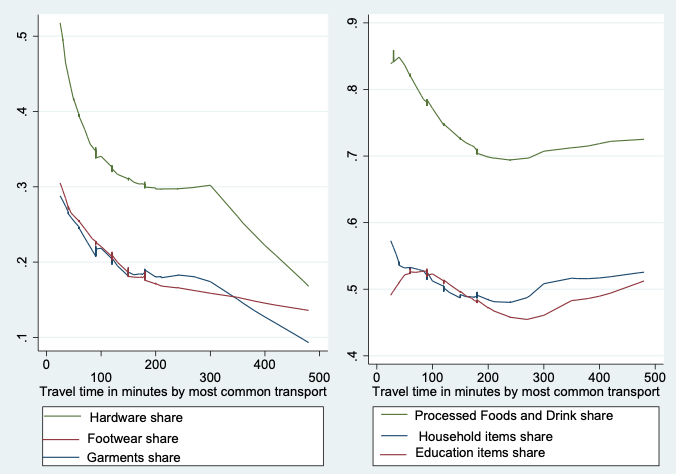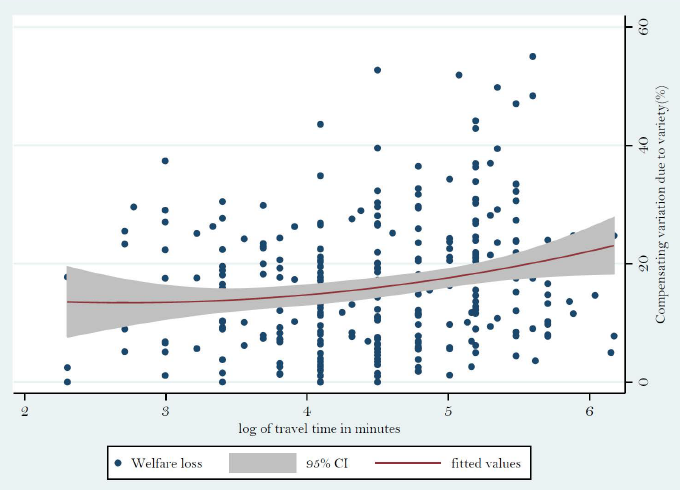
Transport costs, income, and market size affect variety and prices in villages. Infrastructure investment is thus key to consumer welfare.
A simple scan of the shelves of a village shop in a poor country will tell you that there is little in the way of variety in manufactured consumer goods. More remote communities face a sharp reduction in choice. The items that are available are usually part of a basic set of necessary consumption goods, comprising basic clothing, footwear, hygiene, kitchen housewares, and educational items. Distance and associated transport costs are a large part of the explanation. These costs reduce consumer welfare, not only through lower incomes and higher prices, but also through reduced variety in goods available.
The study: Low market access and consumer welfare in remote Ethiopia
Atkin and Donaldson (2015) analyse the effects of trade costs and mark-ups on reducing the surplus and market access of remote consumers. Our focus is on the loss in welfare due to lower availability of consumer goods in remote areas. To document this, we use data from a purpose-designed survey of shops and consumers in towns and villages in Ethiopia.
We find that remoteness sharply reduces the variety of consumer goods available. For an average village, a fall of an hour in travel time is associated with an increase of about nine items or 18 brands of these items. The consequences of fading choice are economically meaningful: We estimate that the welfare effects of falling variety average 16% of consumer expenditures on manufactured goods.
Remoteness: Transport costs and access to manufactured goods
Ethiopia is an economy where issues of high transport costs are particularly salient. The country is landlocked and internal trade costs are strongly affected by its particular physical geography. It has a mean elevation of over 1000 metres and the bulk of the population lives on the high plateau, a terrain wrinkled with steep hills and mountains.
As a result, Ethiopia has one of the lowest road densities in the world, despite substantial investment in new roads over the last decade. In addition, the low urbanisation rates (at 17% compared to a sub-Saharan average of 33%) imply that households face markets distant from them. This particularly affects their access to manufactured goods.
Rural households produce much of their own food, and many services can be produced locally in rural areas, but manufactured goods are typically either imported from abroad or produced in a small number of locations around the country. This means that domestic transport costs are likely to play a significant role in the availability of manufactured goods in Ethiopia’s rural communities.
Remoteness affects product variety along several margins:
- In remote areas, productivity is low and poverty is high. If the demand for variety has a positive incomeelasticity, then remoteness will be associated with a reduction in variety.
- High transport costs imply that individual varieties will be more costly in rural areas. With any fixed cost of varietal marketing, this will give rise to a reduction in the set of varieties.
- The pricing power of retailers in remote areas – where market size may be too small to support much competition – may imply that shopkeepers prefer to restrict the set of varieties in order to focus on products with high margins.
The data: Examining product variety in remote Ethiopia
To examine these dynamics, we conducted a survey of 290 villages in 100 districts across the four main regions of Ethiopia. Villages were chosen so that the local market town was the only supplier of consumer goods so that it could serve as a benchmark for local availability. In brief, we are able to match origin and destination prices.
We focus on manufactured consumer goods: This covers about 20 item groups, from processed foods, drinks, garments, footwear, and cosmetics to kitchenware, hardware, and small electronics. Within these groups there are specific items, such as spaghetti, beer, soap, plastic tableware, linens, notebooks, and batteries, and we can further disaggregate these by brands.
Data were collected in shops in the market towns closest to the villages and in shops and periodic markets (served by traders) in villages. Village officials and six households in each village were surveyed as well. These data allow us to examine how transport costs, incomes, the income distribution, and size of the local market affect the fraction of items available in a remote village compared to its nearest market town.
The findings: Falling variety and the fixed costs of remoteness
The first graph shows how the number of items drops off as transport times to town increase. There are sharp falls within 90 minutes of travel from town in the availability of processed foods and drink, while garments, footwear, hardware, and electronics fade away even faster with time to travel to town.
Figure 1 Share of items available in village relative to nearest town by travel time to town

Note: The figures display the lowess graphs of shares of items available in the village relative to the associated market town. Heavier, bulkier items, such as processed food, drink, and hardware, see a sharper fall in availability by travel time.
Part of the reason for the diminishing variety in remote villages are the fixed costs involved in taking goods further down the road. These costs include licences (for items), payment to village authorities, the costs of own transport and accommodation for itinerant traders as well as inventory and storage costs. Thirty eight percent of traders quote licences required (often by item type) as the reason for not trading other items, 33% quote lack of capital, while 20% claim that the lack of demand in remoter areas dissuades them from carrying more items.
We establish that travel times to town, the level and distribution of income, and the size of the local market all serve to affect availability in the village:
- Availability in a village increases by about four items for every half hour closer to town
- An increase in market size of 10% (an additional hamlet) raises availability by about 12 items.
- The average number of items in a village two hours from town is 43 relative to the 95 items available in town.
The welfare impacts of falling variety in manufactured goods
To assess the welfare impacts of living in remote areas, we employ a standard Dixit-Stiglitz model of monopolistic competition among traders in manufactured goods. We use data on prices paid in town for identical (branded) items and the prices they are sold for in the village using two separate surveys to validate the data.
We estimate an average mark-up of 10-15%. This also allows us to estimate the welfare costs of low availability (and higher prices) of varieties of manufactured goods in terms of the compensating variation: If availability falls, what is the equivalent loss measured as a percentage of spending on manufactured consumer goods?
To obtain this, we use the standard Sato-Vartia framework and estimates of the village-market town price differential as a result of transport costs and mark-ups, to find that the average welfare loss over space due to the loss in variety is 16% of spending on manufactured goods. The graph below describes the variation in welfare costs by time to travel to town.
Figure 2 Welfare loss due to variety as share of expenditures on manufactured goods by travel time to town

Note: The graph above describes the loss in welfare due to a fall in items in the village compared to the market town.
Additional evidence comes from a parallel piece (Krishnan and Zhang 2019). Here, we focus on the variety in the basket of goods consumed by households, rather than the supply offered by retailers in the remote locations above. We examine the loss in variety in household consumption in remote locations, relying on another purpose-designed longitudinal survey over two years, where villages differ only in distance to the market and are homogeneous otherwise.
In addition, we exploit a change in policy, which resulted in a crackdown on informal, unlicensed traders in the second year and affected only the more remote set of villages. Variety in household consumption of manufactured goods falls with distance and time to travel to the main market town. The crackdown on informal traders, as a quasi-experiment resulting in an increase in travel costs, also leads to a decrease in the variety consumed of manufactured goods for households served by the unlicensed traders.
Implications: Infrastructure investment is key to improving welfare
The research shows how variety in manufactured goods fades with distance. Reductions in transport costs increase consumer welfare through lower prices and increased variety. This also has implications for welfare measurement: Poverty is underestimated since people in remote places have little in the way of choice – but equally, when changes in infrastructure raise availability, rates in the decline in poverty will be underestimated too.
The findings thus demonstrate:
- That there are significant welfare losses to low variety in manufactured goods and that intra-trade costs (both mark-ups and transport costs) matter in affecting this margin.
- The cost of loss in variety across space of 16% of consumer expenditures on manufactured goods on average (and 21% due to prices on average) is substantial, reflecting the fact that Ethiopian consumers in villages distant from the nearest town lose both variety in basic consumer goods and face higher prices at destination.
In brief, the investment in infrastructure by the government has been vital in the reduction in poverty seen in Ethiopia over the last decade, but it remains equally vital that this investment continues.
References
Atkin, D and Donaldson, D (2015). “‘Who's Getting Globalized? The Size and Implications of Intranational Trade Costs’”, NBER Working Paper 21439.
Gunning, J W, P Krishnan and A T Mengistu (2019), “Fading Choice: Transport Costs and Variety in Consumer Goods”, CEPR Discussion Paper 15764.
Krishnan, P and P Zhang (2020), “Restricting trade and reducing variety: Evidence from Ethiopia”, World Development 126: 1-11.




